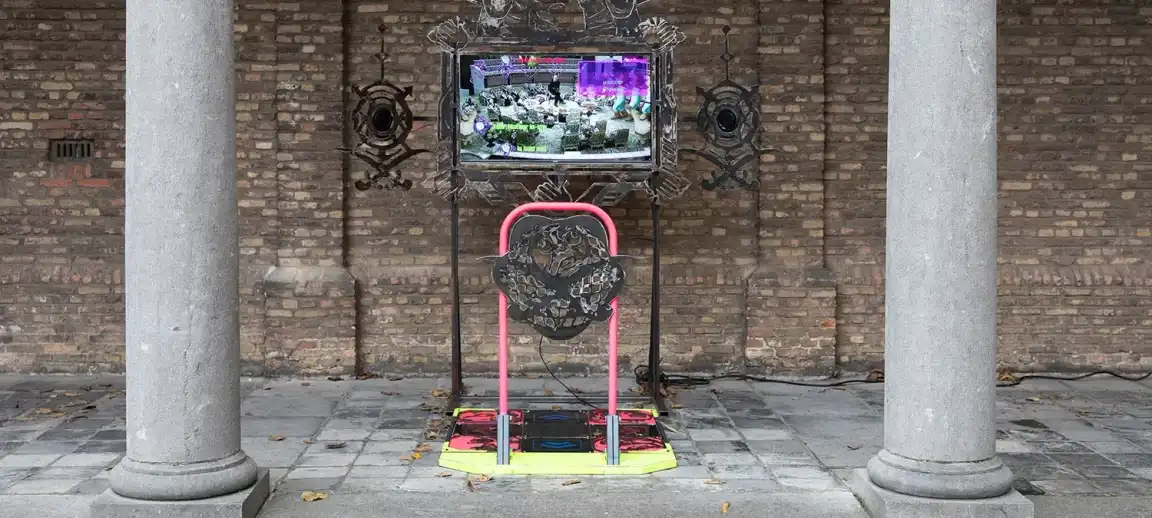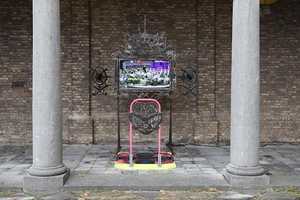Clapback Fury (2021) by Saeeda Saeed
Commissioned by Hartwig Art Foundation. In the collection of Cultural Heritage Agency of the Netherlands (RCE)
Clapback Fury faces a number of preservation challenges but the greatest have to do with its dependency on Twitter, which became X in the Summer of 2023. When Twitter became X the Twitter API was also broken, in effect breaking any number of works that counted it among their external dependencies. Thus this case study began with examining how to restore this disrupted functionality but more pressing challenges regarding the source code were quickly discovered and required immediate action.
Brief Description of the Work
Clapback Fury is a time-based media art installation conceptually based on the old arcade favorite Dance Dance Revolution by a Saudi Arabian artist working under the pseudonym, Saeeda Saeed. Comparable to the gameplay of Dance Dance Revolution, each step produces nonsensical meme insults and directly tags Saudi state-run accounts with the intent of drowning out official tweets. Clapback Fury makes use of a monitor connected to a laptop and a dance pad via an Arduino with two speakers and a subwoofer to amplify a soundtrack. The player accrues three short phrases that make up a nonsensical insult plus the handle of a state-run Saudi Arabian Twitter account. When the player has successfully completed this, they are taken to a victory screen which informs them that their tweet is being sent to the selected twitter account.
Twitter Activism Meets X
Clapback Fury is largely a political protest piece veiled in the language of the internet and inspired by the Saudi government imposed restrictions to freedom of speech. Beginning with the components of the title: “clapback,” internet slang, meaning to respond to an opponent’s insult with a stronger one and “fury” referring to wild or violent anger. Since Saudi Arabia has the largest population of Twitter users in the Middle East, Saeed began to delve into counter strategies for drowning out state-run Twitter accounts. Through engaging visitors in play she creates an access point through which to engage in small acts of political activism.
Saeed conducted research into different methods for reframing and masking dissent in order to avoid the black list and other punishment. Key among these is her use of memes and nonsense as a masking mechanism. Memes with their inherent anonymity created the perfect visual lexicon that only needed to be accented with words. For which the artist described being inspired by Brian Gysin and William S. Boroughs in developing a randomised insult generator.
A randomised insult generated by the work is composed of four parts: 1) Nouns i.e. “Your Aunt,” 2) Transition Words i.e. “works as slow as,” 3) Insults i.e. “a bag of farts,” 4) Twitter Accounts i.e. “(a)Akhbaar24.” For the targeted Twitter accounts Saeed researched the reach and success of Saudi state-run Twitter accounts, narrowing it down to around ten accounts which due to their slow response times could form a platform against which to post alternative narratives. The nonsensical nature of the generated insults tweeted would ensure that they were not taken as an outright threat. For Clapback Fury’s only exhibition instance, from November 13th to December 18th, 2021 at the Vleeshal in Middelburg, Saeed created a series of back-up Twitter developer accounts which could be used to replace any that might be blocked by the platform.

Image depicting Clapback Fury as it was installed at the Vleeshal in Middelburg. Picture credit: Franz Mueller Schmidt
After its exhibition it was donated to the RCE. Between 2021 to the beginning of 2023 major changes were made to the proprietary services on which the work depends as Twitter became X. In 2022 when Elon Musk purchased Twitter he not only outwardly rebranded the platform as X.com but also internally changed a lot of the social media platforms technical infrastructure. One aspect that has had enormous consequences for this work, as well as others, is the discontinuation of the free Twitter API in February 2023, in effect removing the work’s ability to tweet. This problem was further exacerbated by a number of other factors related to the technical composition of the work.
Condition and Preservation Outlook
Clapback Fury can be said to be composed of four main parts: the hardware that composes the installation, the Arduino protocol, the game built in Unity, and the external dependencies that encompass its connection to Twitter. The hardware, including the connectivity with the Arduino, was found to be in good working condition. Yet, preservation obstacles were encountered with the last two parts, related to their proprietary nature. The first of these has to do with the main software component of the work, “Insults,” which was made as a project in Unity, a proprietary service for creating games, applications and experiences. When a project is compiled in Unity that means that changes can no longer be made in the source code, in effect severely limiting the preservation options available to the work. The second has to do with the work’s external dependency on Twitter and the recent technical infrastructure changes it has undergone in the process of becoming X.
When the work was acquired the artist provided the login credentials for an associated Twitter account that had been used by the work to tweet upon successfully reaching the victory screen of the game. This Twitter account was found to have been deactivated in line with X’s new inactivity policy, which removes inactive accounts in order to free up unused handles. This then posed an immediate issue as it became apparent that while the game would still run, upon reaching the victory screen it was no longer tweeting, as the artist had intended. This issue was compacted by lack of input from the artist in the preservation process and the necessity of obtaining the uncompiled source code first in order to have the ability to work on the code’s connectivity to Twitter/X.

Stills from screen recording of Clapback Fury's Unity game software showing the victory screen. Screen recording made by LI-MA
To begin to address this issue LI-MA reached out to ICANCODE, the company which had created the Unity project and developed the work’s connection to Twitter on the artist’s behalf. Other than the work’s inactive Twitter account, it was found that the work’s connectivity with the platform had additionally relied on a relay server, which formed an interim step between the code and Twitter. This relay server is property of the artist.
This created a dilemma concerning whether to create a work around to be able to Tweet or to make the ethical decision to aim for sufficient documentation over a renewed functionality without the artist’s input. LI-MA opted for this later option which while it does not permit the work to Tweet as is the artist’s intention, leaves open more preservation options than before in regards to a restoration that would address this integral characteristic of the work. LI-MA will store the uncompiled source code, the Arduino protocol, and a disc image of the laptop used for the work’s display on gitlab (in terms of the code), and in its digital depository (for all elements). At the earliest opportunity, these will also be stored on LTO-8.
Research completed by: Dorian Meijnen (Curator, RCE), Sylvia van Schaik (Curator, RCE), Ticho Brouwers (RCE), Ron Kievits (Conservation Specialist), Nicolas Dominguez (CEO, ICANCODE) and Thomas van den Bighelaar (Beardiegames)








